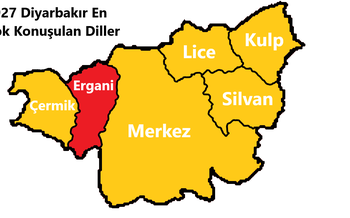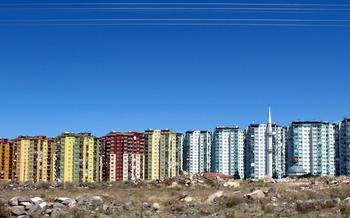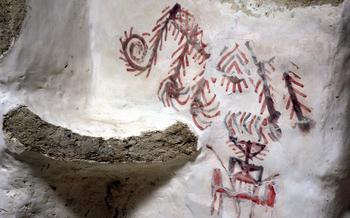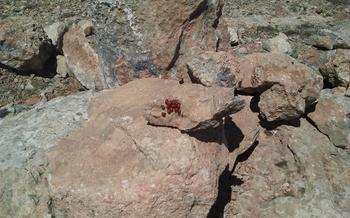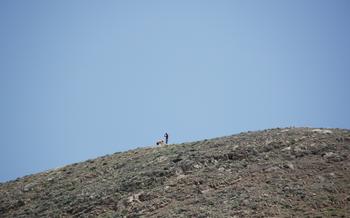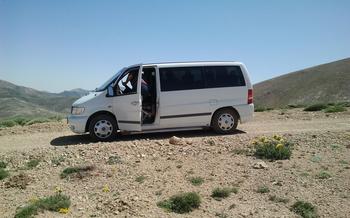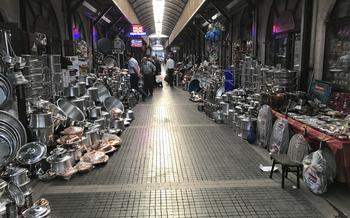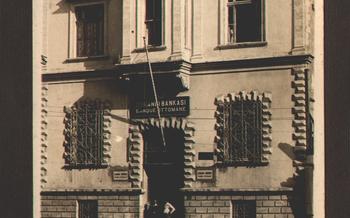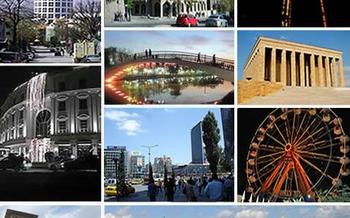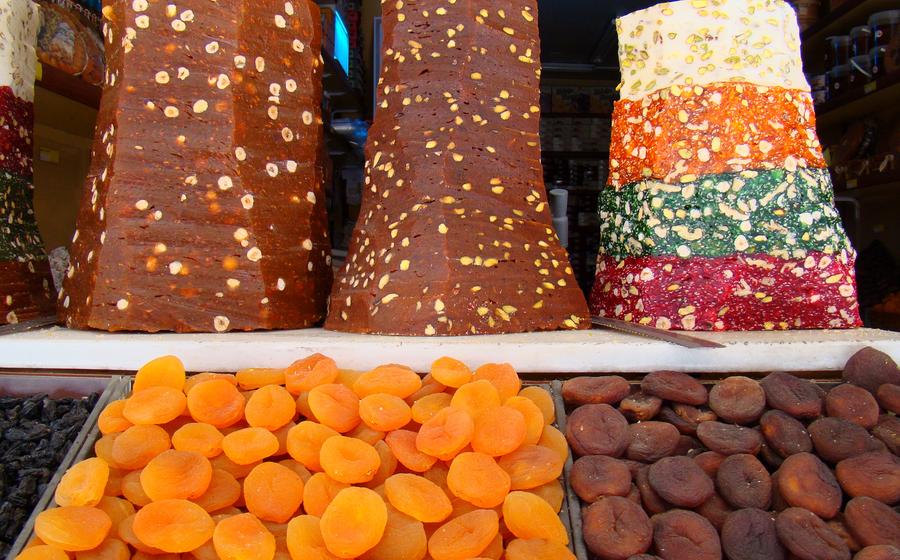
Doğanşehir Ulu Mosque
- The Antiquity of the City and the Mosque's History
- Architectural Marvel
- The Prayer Hall's Grandeur
- The Courtyard's Serenity
- Historical Significance
- Visiting Doğanşehir Ulu Mosque
- Exploring the City of Malatya
- Transportation and Accommodation
- Tips for Respectful Visitation:
- Local Customs and Traditions
- The Mosque's Role in the Community
- The Legacy of the Artuqids
- Exploring the Region's History
- Malatya's Natural Wonders
- Insider Tip
The Antiquity of the City and the Mosque's History
The city of Malatya boasts a rich historical background, dating back to ancient civilizations such as the Hittites, Romans, and Byzantines. Numerous ancient ruins and archaeological sites in the region testify to its long and storied past. Among these historical treasures, the Doğanşehir Ulu Mosque stands as a remarkable legacy of the Artuqid period. Constructed in the 12th century, the Mosque showcases a unique architectural style that blends elements of Seljuk and Anatolian traditions. Its intricate stone carvings, elegant domes, and towering minaret make it a masterpiece of Islamic architecture and a symbol of Malatya's rich cultural heritage.
Architectural Marvel
The Doğanşehir Ulu Mosque stands as a testament to the architectural prowess of the Artuqid dynasty. Its facade is adorned with intricate stone carvings and ornaments, showcasing the artistry and craftsmanship of the period. The central dome, a symbol of Islamic architecture, dominates the skyline, surrounded by a cluster of smaller domes that add grace and symmetry to the structure. The minaret, a slender and graceful tower, serves as a prominent landmark, guiding visitors to this architectural masterpiece.
The Prayer Hall's Grandeur
The interior of the Doğanşehir Ulu Mosque is as impressive as its exterior, boasting a vast prayer hall that exudes an atmosphere of spirituality and reverence. The hall's sheer size and height create a sense of awe, inviting worshippers to immerse themselves in contemplation and prayer.
The Mihrab (prayer niche), the focal point of the hall, is a masterpiece of intricate craftsmanship. Its arched shape is adorned with exquisite carvings and colorful tiles, drawing the eyes towards the Qibla wall, which indicates the direction of Mecca. The Minbar (pulpit), located to the right of the Mihrab, is equally impressive, featuring delicate carvings and geometric patterns that showcase the skill and artistry of the mosque's builders.
The Qibla wall itself holds great significance, as it serves as a guide for worshippers during their prayers. It is adorned with verses from the Quran, reminding the faithful of the importance of seeking guidance and direction from the divine. The overall grandeur of the prayer hall is a testament to the mosque's role as a sacred space, where worshippers can come together to seek solace and connect with their faith.
The Courtyard's Serenity
Within the sacred grounds of the Doğanşehir Ulu Mosque, visitors are embraced by the tranquility of a spacious and serene courtyard. A verdant oasis amidst the urban bustle, the courtyard invites worshippers and visitors alike to pause and reflect upon the divine. Lush green gardens, meticulously manicured, create a verdant tapestry that contrasts beautifully with the mosque's ancient stone facade. The gentle murmur of water fountains, strategically placed throughout the courtyard, adds a soothing ambiance to the serene setting.
Beyond its aesthetic appeal, the courtyard serves a functional purpose, providing a designated space for ablutions before entering the prayer hall. This ritual cleansing, a prerequisite for prayer in Islam, is facilitated by strategically placed water fountains, ensuring that worshippers can purify themselves before engaging in their spiritual devotions. The courtyard also offers a tranquil respite from the hustle and bustle of city life, inviting visitors to momentarily escape the demands of the mundane and immerse themselves in the tranquility of the sacred space.
Historical Significance
The Doğanşehir Ulu Mosque stands as a testament to the rich cultural and religious heritage of Malatya. Throughout history, it has served as a center of spiritual and intellectual pursuits, attracting scholars, pilgrims, and worshippers from far and wide. The Mosque's association with important historical figures and events has further cemented its significance.
During the Artuqid period, the Mosque was a focal point for religious and cultural activities, fostering the development of Islamic art and architecture. It played a crucial role in the dissemination of Islamic knowledge and education, becoming a hub for scholars and students seeking religious guidance and learning.
The Mosque's unique architectural style, blending Seljuk and Anatolian influences, reflects the cultural and artistic diversity of the region. Its intricate carvings, elegant domes, and towering minaret showcase the exceptional craftsmanship and artistry of the Artuqid era.
Over the centuries, the Doğanşehir Ulu Mosque has undergone renovations and expansions, reflecting the changing needs and tastes of the community. These additions and modifications have further enriched the Mosque's historical significance, making it a living testament to the enduring legacy of Islamic architecture.
Today, the Mosque stands as a symbol of Malatya's rich cultural heritage, attracting visitors from around the world who seek to marvel at its architectural splendor and immerse themselves in its spiritual atmosphere.
Visiting Doğanşehir Ulu Mosque
To fully immerse yourself in the spiritual and historical significance of Doğanşehir Ulu Mosque, it is essential to plan your visit carefully. The Mosque is open to visitors daily, but it is recommended to avoid prayer times (typically around dawn, noon, afternoon, sunset, and night) to ensure a peaceful and respectful environment. As a sacred site, visitors are expected to dress modestly and maintain silence while inside the Mosque. Removing shoes before entering is a customary practice, and there are designated areas for storing footwear. Please be mindful of the local customs and traditions, and if you have any questions or concerns, do not hesitate to ask the Mosque's staff or a knowledgeable guide for assistance.
Exploring the City of Malatya
Beyond the Doğanşehir Ulu Mosque, Malatya offers a captivating blend of history, culture, and natural beauty. Delve into the city's rich past at the Malatya Museum, showcasing artifacts from ancient civilizations that once thrived in the region. Discover the impressive ruins of the Arslantepe Mound, an archaeological site dating back to the 4th millennium BC. Immerse yourself in the serene ambiance of the Levent Valley National Park, boasting breathtaking landscapes, cascading waterfalls, and diverse wildlife.
Indulge in Malatya's vibrant culinary scene, tantalizing taste buds with mouthwatering delicacies such as kayısı dolması (stuffed apricots), erişte (noodles with yogurt sauce), and the renowned Malatya apricots, a symbol of the city's agricultural heritage. Savor the flavors of local cuisine at traditional restaurants or bustling street food markets, where the aromas of freshly grilled kebabs and freshly baked pastries fill the air.
Explore the city's vibrant markets, where you can haggle for unique souvenirs, handcrafted textiles, and local delicacies. Experience the warmth and hospitality of the Malatyan people, renowned for their welcoming nature and eagerness to share their culture with visitors. Engage in lively conversations with locals at teahouses or coffee shops, where discussions about history, traditions, and everyday life flow freely.
Malatya's strategic location at the crossroads of ancient trade routes has shaped its diverse cultural heritage. Discover the Armenian Apostolic Church of Surp Hovhannes Mkrtich, a testament to the city's rich religious history. Visit the historic Malatya Castle, perched atop a hill overlooking the city, offering panoramic views and a glimpse into its storied past.
Whether you seek historical exploration, culinary adventures, or simply the chance to connect with the local community, Malatya offers an unforgettable experience for every traveler. Immerse yourself in the city's unique blend of history, culture, and natural beauty, and create lasting memories in this vibrant and welcoming destination.
Transportation and Accommodation
Reaching Malatya is a breeze, with various transportation options available. For those arriving by air, Malatya Airport (MLX) offers convenient connections to major cities within Turkey and abroad. Alternatively, travelers can opt for an overland journey via buses or trains, which provide scenic routes through the picturesque Turkish countryside.
Upon arrival in Malatya, visitors will find a range of accommodation options to suit every budget and preference. From cozy guesthouses and budget hotels to luxurious resorts, there's something for every traveler. The city's central location makes it easy to explore its attractions, with many hotels situated within walking distance of popular landmarks.
For those seeking a more immersive experience, consider renting a car to explore the city and its surroundings at your own pace. Public transportation is also readily available, with buses and taxis providing convenient and affordable ways to get around.
Before embarking on your journey, familiarize yourself with local customs and cultural norms. Respecting local traditions and dressing modestly, especially when visiting religious sites like the Doğanşehir Ulu Mosque, is essential. By embracing the local culture, you'll enhance your travel experience and foster meaningful connections with the warm and welcoming people of Malatya.
Tips for Respectful Visitation:
As visitors to the Doğanşehir Ulu Mosque, it is crucial to demonstrate respect for the religious significance of the site. Proper etiquette should be observed, including dressing modestly and maintaining silence during prayer times. Before entering the Mosque, it is customary to remove shoes as a sign of reverence. Visitors should also be mindful of any specific rules or guidelines displayed within the Mosque and adhere to them accordingly. By showing respect and following these guidelines, visitors can contribute to preserving the sanctity of this sacred space while enriching their understanding of Islamic customs and traditions.
Local Customs and Traditions
Malatya is renowned for its warm hospitality and welcoming nature. The locals take pride in their traditions and customs, which are deeply rooted in Anatolian culture. Visitors are often greeted with open arms and invited to share in the local festivities and celebrations.
One of the most significant aspects of Malatyan culture is its culinary traditions. The city is famous for its delicious cuisine, which features a blend of Turkish and Kurdish flavors. Visitors must try local delicacies such as "Malatya kayısısı" (dried apricots), "Malatya böreği" (a type of savory pastry), and "Malatya mantısı" (a dumpling dish).
Malatya is also known for its vibrant cultural scene. Visitors can enjoy traditional music and dance performances, as well as attend local festivals and events. The city hosts an annual Apricot Festival, which celebrates the region's famous fruit and features various cultural activities.
To fully immerse themselves in the local culture, visitors are encouraged to interact with the friendly locals and learn about their way of life. Respecting local customs and traditions is essential, such as greeting people with a warm handshake and showing respect for elders. By embracing the local culture, visitors can create a truly memorable and enriching experience in Malatya.
The Mosque's Role in the Community
At the heart of the Doğanşehir Ulu Mosque's existence lies its profound connection with the local community. Serving as a spiritual haven and a social hub, the Mosque plays a pivotal role in fostering a sense of unity and belonging among the residents of Malatya. It's a place where the community congregates for religious observances, celebrations, and educational activities.
The Mosque's vast prayer hall resonates with the melodious echoes of communal prayers five times a day, uniting the faithful in their devotion. During the holy month of Ramadan, the Mosque transforms into a center of spiritual reflection and communal feasting, as people gather for Taraweeh prayers and share Iftar meals together.
Beyond its religious significance, the Mosque also serves as a venue for various educational and social initiatives. Classes on Islamic studies, Arabic language, and Quranic recitation are regularly held, fostering a thirst for knowledge and understanding among the community members. The Mosque also hosts lectures, workshops, and seminars on topics ranging from history and culture to contemporary social issues, contributing to the intellectual and cultural enrichment of the community.
Moreover, the Mosque's spacious courtyard provides a tranquil setting for social gatherings and community events. Weddings, circumcision ceremonies, and religious festivals are often celebrated within the Mosque's walls, strengthening the bonds of kinship and camaraderie among the local residents. The Mosque's presence extends beyond its physical structure; it represents a living embodiment of Malatya's rich cultural heritage and the enduring spirit of its community.
The Legacy of the Artuqids
The Artuqids, a prominent dynasty of Turkic origin, ruled over a vast territory in southeastern Anatolia and northern Syria during the 11th and 12th centuries. Known for their military prowess and patronage of the arts, the Artuqids left a lasting legacy in the region, including the magnificent Doğanşehir Ulu Mosque.
The mosque stands as a testament to the Artuqids' architectural mastery and their commitment to Islamic culture. Its intricate stone carvings, elegant arches, and soaring domes showcase the dynasty's unique blend of Seljuk and Byzantine influences. The mosque's construction during the reign of Artuqid Sultan Süleyman ibn İlgazi further solidifies its importance as a symbol of the dynasty's power and prestige.
Beyond the Doğanşehir Ulu Mosque, the Artuqids were responsible for the construction of numerous other mosques, madrasas, and fortifications throughout their realm. Their architectural legacy can be seen in cities such as Mardin, Diyarbakır, and Harput, where Artuqid monuments continue to captivate visitors with their grandeur and artistry.
Exploring the region's Artuqid heritage offers a glimpse into a fascinating chapter of Anatolian history. From the majestic Hasankeyf Castle, perched on a rocky outcrop above the Tigris River, to the intricate stone carvings of the Artuqid Palace in Mardin, the region is dotted with remnants of this once-powerful dynasty.
For history enthusiasts, tracing the footsteps of the Artuqids through their architectural masterpieces provides a deeper understanding of their role in shaping the cultural and historical landscape of southeastern Anatolia.
Exploring the Region's History
Beyond the Doğanşehir Ulu Mosque, the Malatya region is steeped in a rich historical tapestry, inviting visitors to delve into the depths of ancient civilizations and empires. The region served as a crossroads for various cultures, leaving behind a treasure trove of historical sites and attractions that captivate the imagination.
Historical Sites and Ancient Civilizations:
-
Visit the Arslantepe Mound, an archaeological site that dates back to the Bronze Age, revealing the remains of an ancient city-state with impressive fortifications and artifacts.
-
Explore the Hekimhan Castle, a medieval fortress built in the 12th century, offering panoramic views of the surrounding countryside and a glimpse into the region's turbulent past.
-
Discover the Malatya Museum, which houses a vast collection of artifacts from the region's various historical periods, including ancient sculptures, pottery, and inscriptions.
Cultural Heritage and Diverse Population:
-
Immerse yourself in the vibrant cultural heritage of the region, which has been shaped by diverse ethnicities, including Kurds, Turks, and Armenians, each contributing to the unique tapestry of Malatya's culture.
-
Visit the Malatya Armenian Church, a testament to the region's religious diversity and architectural heritage, showcasing intricate Armenian craftsmanship and design.
-
Experience the local cuisine, which blends Turkish, Kurdish, and Armenian influences, resulting in a delectable array of dishes that tantalize the taste buds.
Museums and Archaeological Sites:
-
Delve into the region's past at the Malatya Archaeology and Ethnography Museum, which showcases a comprehensive collection of artifacts from prehistoric times to the Ottoman era.
-
Explore the Darende Museum, located in the nearby town of Darende, which houses a diverse collection of historical artifacts, including Islamic calligraphy, manuscripts, and traditional costumes.
-
Discover the Letoon Archaeological Site, located in the ancient city of Letoon, which features the remains of a temple dedicated to the goddess Leto and her children, Apollo and Artemis.
Malatya's Natural Wonders
The Malatya region boasts a diverse and breathtaking natural landscape that complements its rich history and cultural heritage. Visitors can explore the region's majestic mountains, lush valleys, and meandering rivers, offering a feast for the eyes and an opportunity to connect with nature. The Taurus Mountains, which form the region's backdrop, provide a stunning panorama with their snow-capped peaks and rugged slopes.
One of the region's natural highlights is the Yeşilırmak River, which flows through Malatya and offers opportunities for kayaking, fishing, and scenic walks along its banks. The river's crystal-clear waters and verdant surroundings create a serene and picturesque setting. Visitors can also explore the region's numerous caves, such as the impressive Karagöl Cave, which features stalactites and stalagmites that have formed over millions of years, creating a subterranean wonderland.
The region's diverse flora and fauna add to its natural charm. Visitors can spot various bird species, including eagles, hawks, and falcons, soaring above the mountains and valleys. The region is also home to endemic plant species, such as the Malatya poppy, which blooms in vibrant colors during the spring. For nature enthusiasts, the Malatya region offers a wealth of opportunities for hiking, camping, and wildlife watching, allowing them to immerse themselves in the region's natural beauty and tranquility.
Insider Tip
As I wandered through the tranquil courtyard of the Doğanşehir Ulu Mosque, I stumbled upon a small group of local women gathered around a fountain, engaged in a lively conversation. Curiosity piqued, I approached them and was warmly welcomed into their circle. Over cups of fragrant tea, they shared stories of their lives, their families, and the rich history of Malatya. It was a moment of genuine connection that transcended language barriers and left me with a deep appreciation for the warmth and hospitality of the local community.
My advice to visitors is to embrace every opportunity to interact with the locals. Whether it's chatting with a shopkeeper, dining at a traditional restaurant, or joining a local gathering, these encounters will provide a deeper understanding of Malatya's culture and way of life. Don't be afraid to step out of your comfort zone and immerse yourself in the vibrant tapestry of this historic city.
